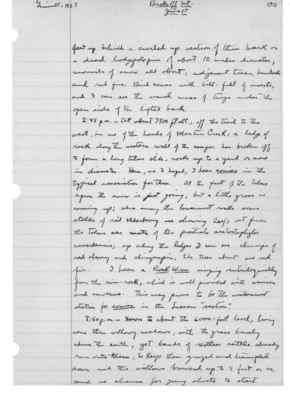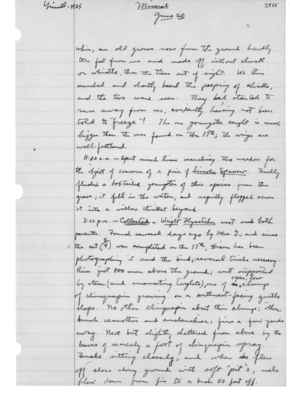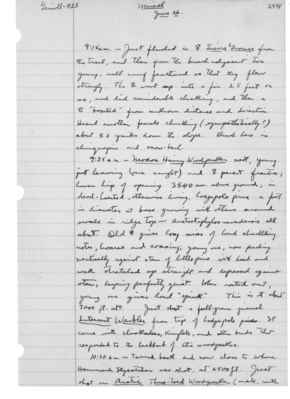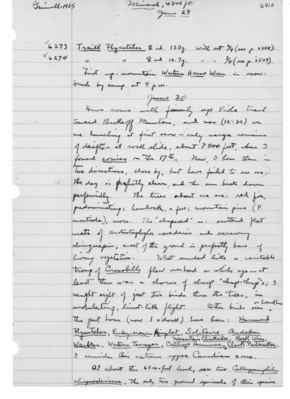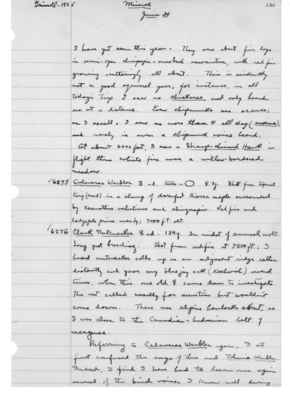Pages That Mention chinquapin
1925: Joseph Grinnell's field notes
S2 Page 18
Collector: Grinnell - 1925 Location: Lassen Section (Brokeoff Mt.) Date: June 17, 1925 Page Number: 2471
feet up behind a curled up section of thin bark on a dead lodgepole pine of about 10 inches diameter; mounds of snow all about; adjacent trees, hemlocks and red firs. Bird comes with bill-full of insects, and I can see the usual mass of twigs under the open side of the lifted park. 2:45 p.m. - At about 7500 ft. alt.; off the trail to the west, in one of the heads of Martin Creek; a ledge of rock along the western wall of the canyon has broken off to form a long talus slide, rocks up to a yard or more in diameter. Here, as I hoped, I hear conies in the typical association for them. At the fast of the Talus apron the snow is just going, but a little grass is coming up; also among the lowermost rocks some stalks of red elderberry are showing leaf; out from the Talus are mats of the prostrate arctostaphylos nevadensis; up along the ledges I can see clumps of red cherry and chinquapin; the trees about are red fir. I hear a Rock Wren singing ventriloquially from the rim-rock, which is well provided with crevices and caverns. This may prove to be the westernmost station for conies in the Lassen "section." 3:50 p.m. - Down to about 600-foot level, having come thru willowy meadows, with the grass barely above the earth, yet bands of restless cattle already run onto them, to keep them grazed and trampled down and the willows browsed up to 5 feet or so, and no chance for young shoots to start.
S2 Page 30
Collector: Grinnell-1925 Location: Mineral Date: June 20 Page Number: 2485
whir, an old grouse rose from the ground hardly ten feet from us and made off without cluck or whistle, thru the trees out of sight. We then marched and shortly heard the peeping of chicks, and the two were seen. They had started to run away from us, evidently having not been told to "freeze"! The one youngster caught is much bigger than the ones found on the 17th; the wings are well-feathered.
11:30 a.m. - Spent much time searching the meadow for the object of concern of a pair of Lincoln Sparrow. Finally flushed a bobtailed youngster of this species from the grass; it fell in the water, and rapidly flopped across it into a willow thicket beyond.
3:00 p.m. - Collected a Wright Flycatcher nest and both parents. Found several days ago by Mrs. G, and since the set (2/4) was completed on the 17th, Dixon has been photographing it and the bird; several trials necessary. Rim just 800 mm. above the ground; nest supported by stem (and innovating twiglets), one of an ^open, low clump of chinquapin growing on a southwest-facing gentle slope. No other chinquapin about this clump; other brush ceanothus and amelanchier; firs a few yards away. Nest but slightly sheltered from above by the leaves of scarcely a foot of chinquapin spray. Female sitting closely, and when she flew off close along ground with soft "pit"s, male flew down from fir to a bush 50 feet off.
S2 Page 44
Collector: Grinnell - 1925 Location: Mineral Date: June 26 Page Number: 2498
9:14 a.m. - Just flushed a [female symbol] Sierra Grouse from the trail, and then from the brush adjacent two young, well enuf feathered so that they flew strongly. The [female symbol] went up into a fir 25 feet or so, and did considerable clucking, and then a [male symbol] "boonted" from unknown distance and direction. Heard another female clucking (sympathetically?) about 50 yards down the slope. Brush here is chinquapin and snow-bush.
9:35 a.m. - Modoc Hairy Woodpecker nest, young just leaving (one caught) and [female symbol] parent frantic; lower lip of opening 3540 mm. above ground; in dead-hearted, otherwise living, lodgepole pine a foot in diameter at base growing with others around swale in ridge top - Arctostaphylos nevadensis all about. Old [female symbol] gives long series of loud chuckling notes, hoarse and coaxing; young one, now perching vertically against stem of little pine with head and neck stretched up straight and depressed against stem, keeping perfectly quiet. When routed out, young one gives loud "spink." This is at about 7000 ft. alt. Just shot a full-grown juvenal Lutescent Warbler from tip of lodgepole pines. It came with chickadees, Kinglets, and other birds that responded to the hubbub of the woodpeckers.
10:30 a.m. - Turned back and now close to where Hammond Flycatcher was shot, at 6500 ft. Just shot an Arctic Three-toed Woodpecker (male, with
S2 Page 57
Collector: Grinnell - 1925 Location: Mineral, 4800 ft. Date: June 29 Page Number: 2510
6273 Traill Flycatcher [female symbol] ad. 13.0 g. with set 3/4 (see p. 2508). 6274 Traill] [Flycatcher] [female symbol] ad. 12.7 g. [with] [set] 3/4 (see p. 2509).
First up - mountain Western House Wren in snow brush by camp at 4 p.m.
June 30 Have come with family up Viola trail towards Brokeoff Mountain, and now (12:30) we are lunching at first snow - only meagre remains of drifts - at rock slide, about 7500 feet, where I found conies on the 17th. Now, I hear them in two directions, close by, but have failed to see one. The day is perfectly clear, and the sun beats down perfervidly. The trees about me are: red fir, predominating; hemlock, a few; mountain pine (P. monticola), more. The "chaparral" is: scattered flat mats of arctostaphylos nevadensis and scrawny chinquapin; most of the ground is perfectly bare of living vegetation. What sounded like a veritable troup of Crossbills flew overhead a while ago - at least there was a chorus of sharp "chup-chup's"; I caught sight of just two birds thru the trees, in undulating, linnet-like flight. Other birds seen ^or heard here the past hour (now 1 o'clock) have been: Hammond Flycatcher, Ruby-crown Kinglet, Solitaire, Audubon Warbler, Western Tanager, Calliope Hummer,^ Mountain Chickadee, Rock Wren, Clark Nutcracker. I consider this extreme upper Canadian zone.
At about 6500-foot level, saw two Callospermophilus chrysodeirus, the only two ground squirrels of this species
S2 Page 58
Collector: Grinnell - 1925 Location: Mineral Date: June 30 Page Number: 2511
I have yet seen this year. They were about fir logs in semi-open chinquapin-snowbush association, with red fir growing scatteringly all about. This is evidently not a good squirrel year; for instance, in all today's trip I saw no chickaree, and only heard one at a distance. Even chipmunks are scarce; as I recall, I saw no more than 4 all day (amoenus), and rarely is even a chipmunk voice heard.
At about 6000 feet, I saw a Sharp-shinned Hawk in flight thru the white firs near a willow-bordered meadow.
6275 Calaveras Warbler [male symbol] ad. testes - [testes illustration] 8.3 g, Shot from topmost twig (dead) in a clump of dwarfed Sierra maple surrounded by ceanothus velutinus and chinquapin. Red firs and lodgepole pine nearby; 7000 ft. alt.
6276 Clark Nutcracker [female symbol] ad. 134 g. In midst of annual molt. Long past breeding. Shot from red fir at 7500 ft.: I heard nutcracker calls up on an adjacent ridge rather distantly and gave my bluejay call (Kochwish) several times, when this one old [female symbol] came down to investigate. The rest called nasally for sometime but wouldn't come down. There were alpine hemlocks about, so I was close to the Canadian-hudsonian belt of mergence.
Referring to the Calaveras Warbler again, I at first confused the songs of this and Tolmie Warbler. Indeed, I find I have had to learn over again several of the bird voices I knew well during
